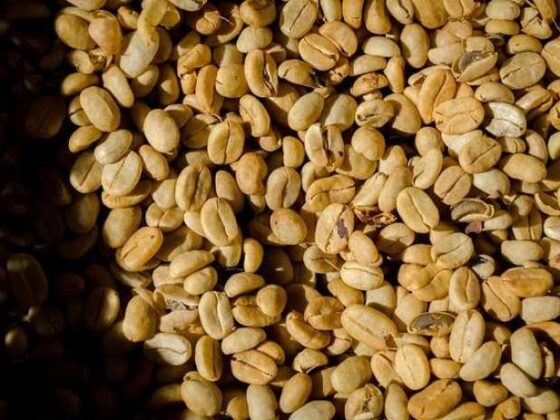Title: everything You Need to Know About Growing Coffee Beans! ☕️
Hey there, coffee lovers! If you’re anything like us, your day doesn’t start untill that first glorious sip of coffee lands in your mug. But have you ever thought about what it would be like to grow your own coffee beans? Yep,we’re talking about embarking on a journey from seed to brew right in your own backyard (or balcony)! 🌱✨
In this article,we’re diving into everything you need to know about nurturing those little green beans—how to plant them,care for them,and transform them into your favorite cup of joe. Whether you’re a seasoned gardener looking to diversify your green thumb experience or a coffee fanatic curious about taking your passion to the next level, we’ve got you covered. So grab a cup of your go-to brew, settle in, and let’s chat coffee cultivation!
Choosing the Right Coffee Variety for Your Garden Bliss
When diving into the world of coffee cultivation, the first step is choosing the right variety that suits your garden’s habitat and your personal taste. Coffee beans are primarily divided into two main species: Arabica and robusta. Each variety brings its unique character, flavor profile, and growth requirements. If you crave a smooth, sweet flavor with a hint of acidity, Arabica might be your best bet. Conversely, Robusta coffee is known for its bold, earthy taste and higher caffeine content, making it an excellent choice for espresso lovers. Don’t forget to consider your local climate, as some varieties thrive in specific conditions, while others are more forgiving.
To help with your decision, here are a few fun facts about each variety:
- Arabica: Prefers cooler temperatures and grows best in elevations of 2,000 to 6,000 feet.
- Robusta: Grows at lower altitudes and can withstand warmer climates.
- Arabica: Typically more sensitive to pests and diseases.
- Robusta: More resilient, making it an easier option for beginners.
In addition, consider hybrids or specialty varieties if you’re feeling adventurous.Some of these unique options can offer distinctive flavors and are engineered for specific growing conditions.
| Variety | Flavor Profile | Growth Conditions |
|---|---|---|
| Arabica | Smooth, Nutty, Sweet | Cool Temperatures |
| Robusta | Bitter, Earthy, Strong | Warm Temperatures |
| Excelsa (Hybrid) | Fruity, Floral | Varied Elevations |
The Perfect Soil Mix: Secrets to Happy Coffee Plants
Creating the ideal soil mix for your coffee plants is a balance of science and art, aimed at mimicking their native tropical environment. Start with a base of high-quality potting soil that allows for excellent drainage, as coffee plants dislike being waterlogged. Mixing your soil with organic materials will add nutrients and enhance its structure. Consider adding:
- Compost: A great source of nutrients that enriches the soil.
- Pine bark: Improves aeration and drainage.
- Perlite or vermiculite: Helps retain moisture while offering excellent drainage.
A key aspect of the mix is the pH level, which should be slightly acidic, ideally between 6.0 and 6.5. To achieve this,you can incorporate elemental sulfur or peat moss into your blend.Regularly testing your soil pH will ensure your coffee plants are getting the optimal nutrition for robust growth. Here’s a simple chart to guide you on ingredient proportions for your perfect soil mix:
| Ingredient | Proportion |
|---|---|
| Potting Soil | 40% |
| Compost | 30% |
| Pine Bark | 20% |
| Perlite/Vermiculite | 10% |

Sunshine and Water: Mastering the Coffee growth Environment
When it comes to cultivating those tasty coffee beans that fuel our daily routines, two elements are absolutely vital: sunshine and water. Coffee plants thrive in a climate that offers 6-8 hours of direct sunlight each day. while they love their sunshine,it’s crucial to note that luminous,indirect light can also benefit them,especially during the hottest periods of the day. Finding that perfect balance helps your plants flourish. A great tip is to plant your coffee in slightly shaded areas if you’re in a particularly blazing location, as this can help prevent leaf burn and keep the soil moisture levels stable.
Speaking of moisture, the amount and frequency of water can make or break your coffee-growing adventure. Coffee plants prefer well-draining soil that retains some moisture, so consider incorporating organic matter to maintain that balance.To keep your plants happy, aim for a watering schedule that delivers the right amount without over-saturating the roots. Here’s a simple guide to help you nail down your watering routine:
| Season | Frequency |
|---|---|
| Spring | Every 3-4 days |
| Summer | Every 2-3 days |
| Fall | Every 4-5 days |
| Winter | Once a week |
By understanding your coffee plants’ requirements for sunlight and water, you’ll be well on your way to creating the ideal environment for robust and flavorful coffee beans. Just remember: watch the leaves—they’ll tell you if they’re too thirsty or getting too much sun!
Harvesting and Processing Your Beans Like a Pro
Once your coffee cherries are ripe and ready for picking, it’s essential to harvest them properly to ensure quality beans. Aim for a selective picking method,where only the red cherries are harvested,leaving the unripe green ones behind. This not only enhances the flavor profile of your coffee but also maintains the integrity of the plant. After harvesting, it’s crucial to process your cherries quickly to prevent spoilage. Here are the primary processing methods:
- Wet Processing: This method involves removing the outer skin and pulp before fermenting the beans in water. the beans are then washed and dried.
- Dry Processing: In this method, cherries are spread out in the sun to dry, allowing the beans to absorb flavors from the fruit before being hulled.
- Honey Processing: This technique is a hybrid of wet and dry methods, where some fruit mucilage is left on the bean during the drying phase, leading to a unique taste.
Following your choice of processing, proper drying techniques play a crucial role in preserving flavor and preventing mold. Ideally, your beans should be dried to about 11-12% moisture content.A simple way to gauge this is by using a moisture meter. Once dried, it’s time to store your beans correctly to maintain their freshness. Use airtight containers in a cool,dark place. Here’s a swift rundown of storage tips:
| Storage Method | Description |
|---|---|
| Glass Jars | Best for short-term storage. Ensure they are dark or opaque to block light. |
| Vacuum Sealing | Ideal for long-term storage. Removes air exposure that can degrade quality. |
| Freezing | Great for long periods. Just ensure they are in a sealed bag to prevent freezer burn. |
Q&A
Sure! Here’s a fun and informal Q&A for your blog article titled “everything You Need to Know About Growing Coffee Beans!”
Q&A: Everything You Need to Know About Growing Coffee Beans!
Q: Can I really grow coffee beans at home?
A: Absolutely! If you’ve got a sunny spot and a little patience, you can grow your own coffee beans right at home. Just keep in mind that coffee plants love warmth, so they’re best suited for those living in warmer climates (think zones 10-11). But even folks in cooler areas can grow them in pots and bring them inside during the chilly months!
Q: What’s the first step to growing coffee?
A: Starting with quality seeds or seedlings is key. you can plant coffee seeds directly in the ground if your climate permits or start with young plants from a nursery. Just make sure they’re robust and healthy!
Q: What kind of soil do coffee plants like?
A: Coffee plants prefer well-draining,rich organic soil with a pH between 6.0 and 6.5.You want a blend that supports good drainage but still retains some moisture.think of it like the perfect cake batter – not too dry, not too wet!
Q: How much sunlight dose a coffee plant need?
A: Coffee plants thrive in bright, indirect sunlight. Too much direct sun can scorch their leaves, so find that sweet spot where they can soak up the light without suffering. They’re like your chill, sunbathing friend who prefers the shade!
Q: How often do I need to water my coffee plants?
A: It’s all about keeping that balance. Coffee plants like their soil to be moist but not soggy. Water them when the top inch of soil feels dry to the touch. Be careful not to overwater, or you might end up with root rot – yikes!
Q: What kind of pests should I watch out for?
A: Be on the lookout for common pests like aphids, mealybugs, or spider mites. If you spot any creepy-crawlies,a simple blast of water or a gentle spray of insecticidal soap can help fend them off. Just don’t go too crazy with the chemicals – keep it as natural as possible!
Q: How long does it take for coffee plants to produce beans?
A: Patience, my friend! Coffee plants usually take about 3 to 4 years to start producing cherries (the fruit that contains the beans). But once they start, they can keep producing for several decades. It’s a long-game commitment,but well worth the wait!
Q: How do I harvest my coffee beans?
A: When the cherries turn a nice,bright red,it’s time to pick! You can either handpick them individually for the best quality or do a “strip pick,” where you remove everything at once. Just remember to enjoy the process – it’s a labour of love!
Q: What’s the process of turning cherries into beans?
A: After harvesting, the cherries need to be processed quickly to prevent spoilage.You can choose between wet or dry processing. Wet processing involves removing the pulp and fermenting the beans for a day or two, while dry processing involves laying the cherries out in the sun to dry. Both methods are a bit of a hands-on project but so rewarding!
Q: Any last tips for newbie coffee growers?
A: Have fun with it! Don’t get discouraged if things don’t go perfectly the first time around. Each plant is a learning experience. Join online communities or local gardening groups to swap stories and advice. And remember, the smell of freshly brewed coffee made from your own beans? Totally worth all the effort!
There you go! this informal Q&A format should make the data engaging and easy to digest for your readers. Happy blogging!
To Conclude
And there you have it, coffee lovers! You’re now armed with all the knowledge you need to start growing your very own coffee beans.From selecting the right variety to mastering the art of brewing your homegrown harvest, this journey is sure to be as rich and rewarding as a freshly brewed cup of java. So roll up those sleeves, put on your gardening gloves, and get ready to sip on your very own brew. Remember, patience is key—just like your favorite roast, good things take time.
If you have any questions or want to share your coffee-growing adventures, drop a comment below! And who knows—you might just inspire the next barista-in-training. Happy growing, and cheers to your coffee dreams becoming a reality! ☕🌱











